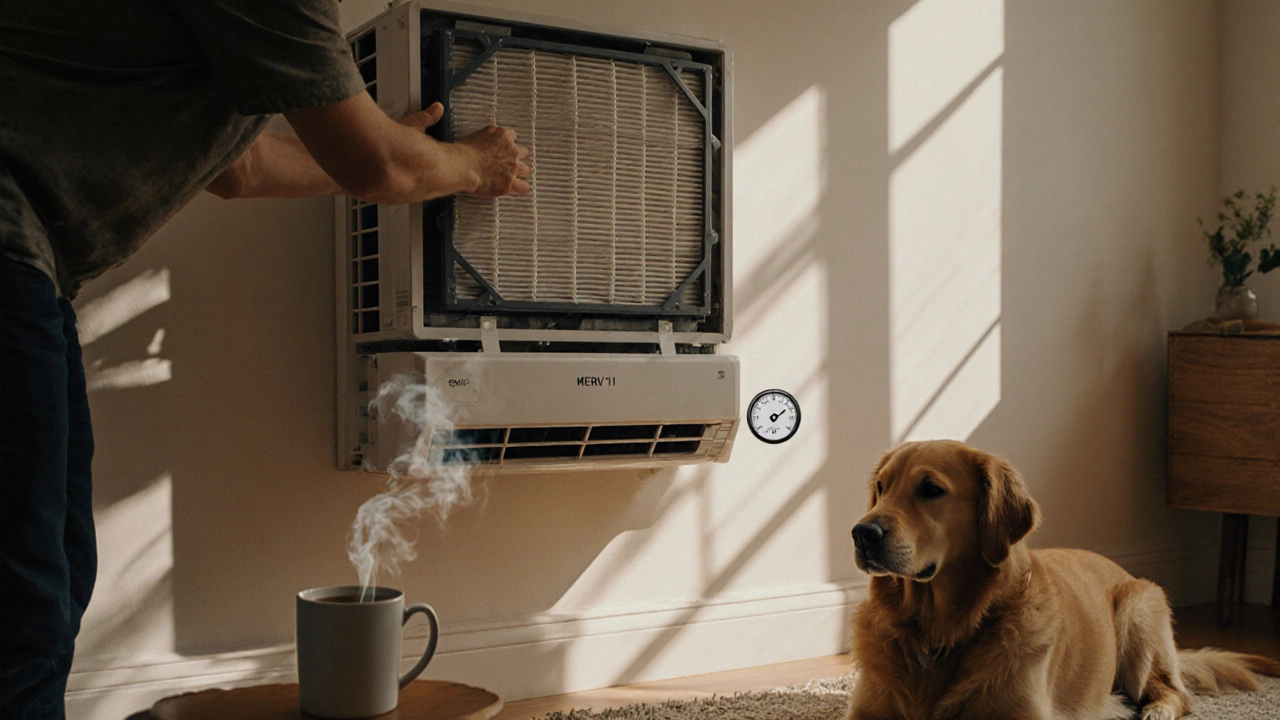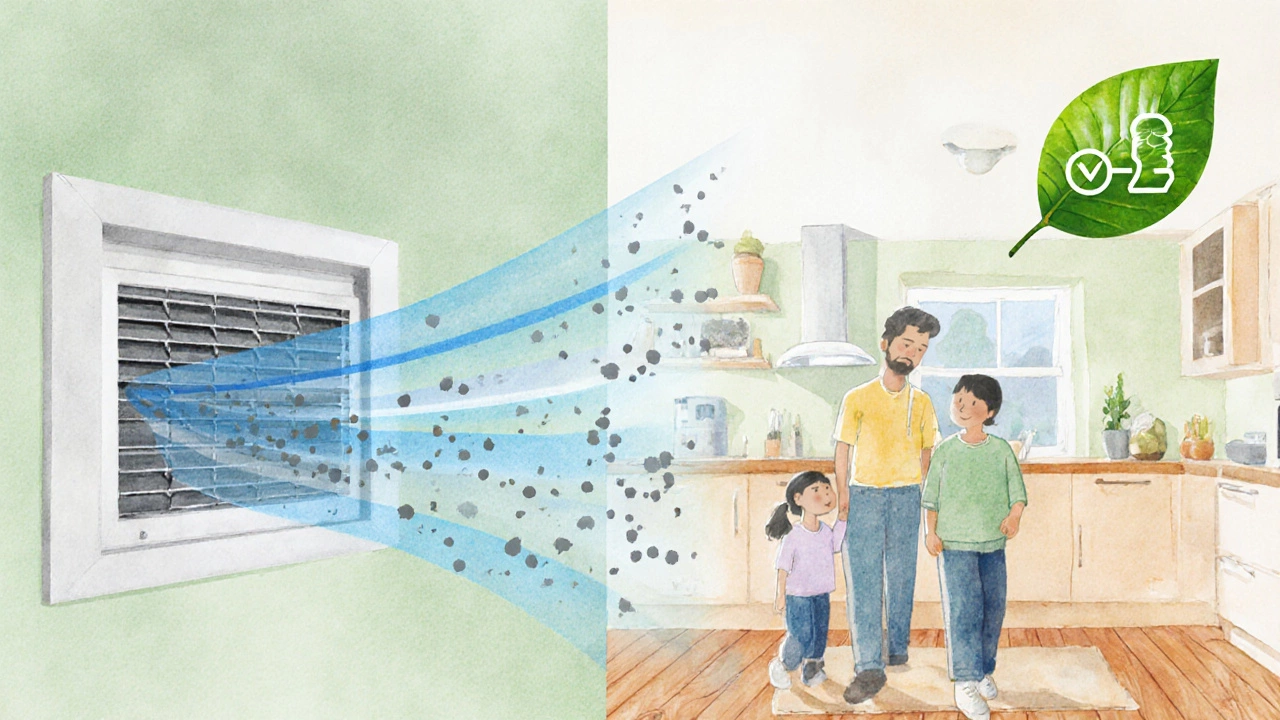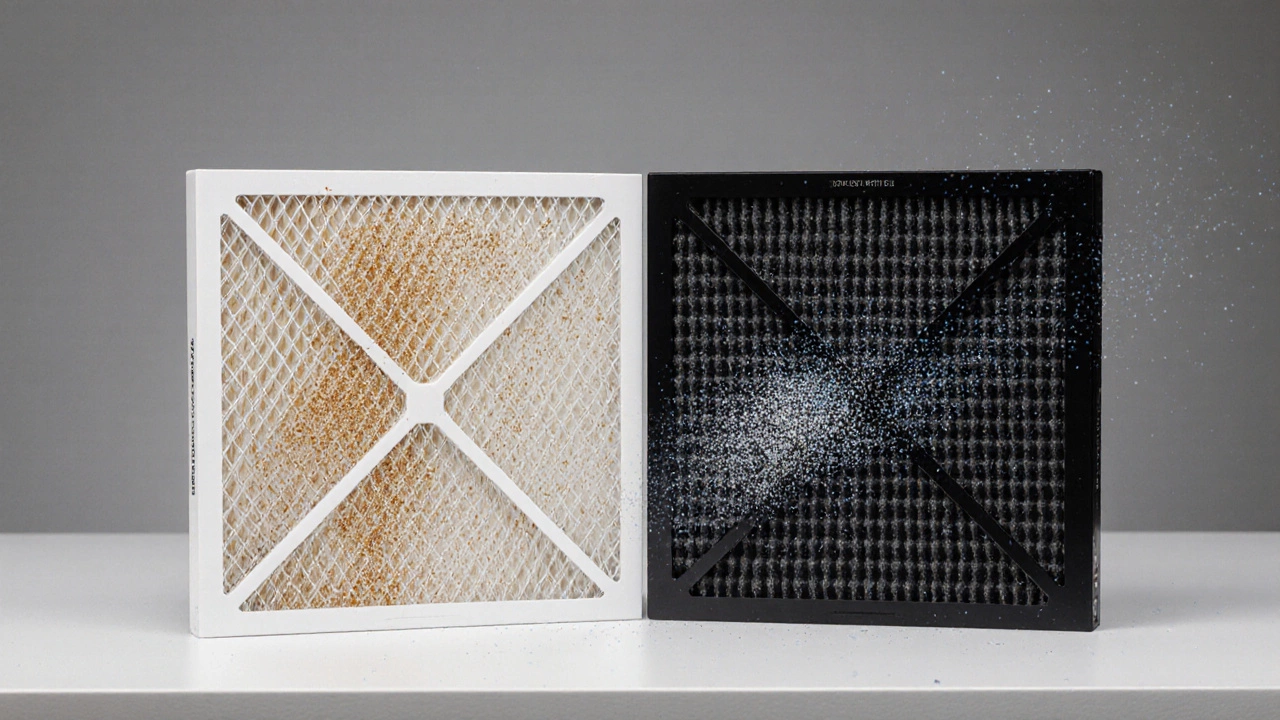MERV Filter Performance Calculator
Filter Selection Calculator
Answer these questions to determine the best air filter for your home.
Pro Tip
Check your HVAC manual for the maximum static pressure rating. Most modern systems handle up to 0.5 in. wg, while older units typically max out at 0.3 in. wg.
When it comes to home air filtration, MERV 8 is often the baseline, but many homeowners wonder if stepping up to MERV 11 really makes a difference. In this guide we break down what each rating means, how they perform in real‑world conditions, and which one fits your house, budget, and HVAC system best.
Key Takeaways
- MERV 8 captures most dust, pollen, and larger mold spores, making it suitable for standard homes without severe allergy concerns.
- MERV 11 adds a noticeable boost for finer particles like pet dander, smoke, and some PM2.5, but it also creates a higher pressure drop.
- Choose MERV 8 if your system is older, you need low energy costs, or you have no specific health concerns.
- Opt for MERV 11 when you have pets, smokers, or asthma sufferers and your HVAC can handle the extra resistance.
- Regular filter changes (every 3-6 months) keep performance consistent regardless of rating.
What Is a MERV Rating?
Air filter is a component of a heating, ventilation, and air conditioning (HVAC) system that traps airborne particles. The MERV rating (Minimum Efficiency Reporting Value) is a standard developed by ASHRAE (the American Society of Heating, Refrigerating and Air‑Conditioning Engineers) to quantify how well a filter captures particles of different sizes.
MERV scores range from 1 to 16 for residential filters. The higher the number, the narrower the pores and the better the capture efficiency. However, higher ratings also increase airflow resistance, which can strain fans and raise energy use.
Understanding MERV 8
MERV 8 filters are often classified as “mid‑range.” They capture:
- 75‑85% of particles sized 3-10 µm (dust, pollen, mold spores).
- Under 50% of particles 1-3 µm (some pet dander, larger smoke particles).
Typical construction: a thin layer of pleated polyester or a fiberglass mat. Because the material is relatively open, pressure drop stays low (around 0.2‑0.3 inches of water gauge), meaning your blower motor runs efficiently.
Best for:
- Homes without allergic occupants.
- Older HVAC units that can’t handle high static pressure.
- Budget‑conscious households - MERV 8 filters usually cost £5‑£8 per unit.

Understanding MERV 11
MERV 11 pushes the capture envelope further. Efficiency rates jump to:
- 85‑90% for 3-10 µm particles.
- 65‑80% for 1-3 µm particles, including most pet dander, smoke, and some PM2.5 (particles ≤2.5 µm).
The tighter pleated media creates a higher pressure drop (0.3‑0.5 in. wg). Modern fans can usually handle this, but older units may see reduced airflow and higher electricity bills (≈5‑10% increase).
Best for:
- Households with pets, smokers, or asthma sufferers.
- Newer HVAC systems rated for up to 0.5 in. wg static pressure.
- Those willing to spend a bit more (£9‑£12 per filter) for cleaner indoor air.
Direct Comparison
| Aspect | MERV 8 | MERV 11 |
|---|---|---|
| Particle size captured (1‑3 µm) | ~30‑45% | ~65‑80% |
| Particle size captured (3‑10 µm) | 75‑85% | 85‑90% |
| Typical pressure drop | 0.2‑0.3 in. wg | 0.3‑0.5 in. wg |
| Estimated energy impact | 0‑5% increase | 5‑10% increase |
| Cost per filter (UK) | £5‑£8 | £9‑£12 |
| Ideal for | Standard homes, low‑allergy occupants | Pets, smokers, asthma, newer HVAC |
How to Choose the Right Filter for Your Home
- Assess occupant health needs. If anyone suffers from allergies or asthma, lean toward MERV 11.
- Check your HVAC manual. Look for the maximum static pressure rating; older units often list 0.3 in. wg max.
- Consider your indoor environment. Pet owners, smokers, or homes near high‑traffic roads benefit from the tighter filtration of MERV 11.
- Balance energy costs. If your electricity bill is a concern, calculate the potential 5‑10% rise when moving to MERV 11.
- Factor in replacement frequency. Higher‑efficiency filters can trap more debris, so you may need to change them every 3 months instead of 6.
In practice, many UK families start with MERV 8, monitor indoor dust levels, and upgrade to MERV 11 only if they notice persistent odors or allergy symptoms.

Installation Tips & Maintenance
- Turn off the HVAC system before swapping filters to avoid drawing unfiltered air.
- Note the direction arrow on the filter frame; airflow should move from the clean side to the dirty side.
- Measure the filter slot (height × width × depth) before buying - many retailers list both MERV 8 and 11 in identical sizes.
- Mark the installation date on the frame with a permanent marker; set a calendar reminder for the next change.
- If you notice reduced airflow after a few weeks, consider a deeper clean of ducts before the next filter swap.
Common Pitfalls to Avoid
People often assume higher MERV equals better overall performance, but that’s a simplification. Here are three mistakes to watch out for:
- Over‑loading the system. Installing MERV 11 in a unit rated for 0.3 in. wg can cause the fan motor to overheat, shortening its lifespan.
- Forgetting to replace. A clogged MERV 11 filter can become a breeding ground for mold, undoing the air‑quality benefits.
- Ignoring local climate. In damp UK regions, moisture‑absorbing filters may deteriorate faster; choose a washable electrostatic option if you live in high humidity.
Frequently Asked Questions
Will a MERV 11 filter damage my furnace?
Only if the furnace’s fan is not rated for the higher static pressure. Most modern UK furnaces handle up to 0.5 in. wg, but older models may overheat or lose airflow, leading to higher energy bills.
Can I mix MERV 8 and MERV 11 filters in the same house?
Yes. It’s common to use MERV 11 in bedrooms (where allergy sufferers sleep) and MERV 8 in less critical areas like the garage or utility room.
How often should I change a MERV 11 filter?
Generally every 3‑4 months in a typical UK home, or sooner if you have multiple pets or notice a noticeable drop in airflow.
Is there a noticeable health benefit from upgrading to MERV 11?
Studies by the EPA show that reducing PM2.5 exposure by 20‑30% can lessen asthma attacks and improve overall respiratory comfort, which aligns with the capture rates of MERV 11.
Do MERV 8 filters work with HEPA air purifiers?
HEPA units rely on their own sealed filter system, so the HVAC filter rating (MERV 8 or 11) doesn’t affect the purifier’s performance. However, a cleaner HVAC filter can reduce overall dust load on the HEPA unit, extending its life.
Bottom line: if you have a modern furnace, pets, or family members with respiratory issues, the extra capture power of MERV 11 is worth the modest cost and energy hit. Otherwise, a well‑maintained MERV 8 keeps your system running smoothly without blowing your budget.

